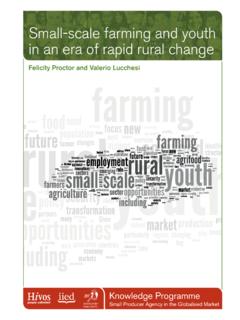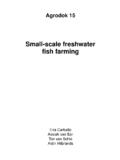Transcription of Profitability and Production Efficiency of Small-Scale ...
1 IOSR Journal of Applied Physics (IOSR-JAP) e-ISSN: 2278-4861. Volume 3, Issue 4 (Mar. - Apr. 2013), PP 19-23 19 | Page Profitability and Production Efficiency of Small-Scale Maize Production in Niger State, Nigeria Sadiq*, Yakasai**, Ahmad**, Lapkene* and Mohammed Abubakar *Department of Agric. Economics and Extension Techn., Federal University of Tech., Minna, Nigeria **Department of Agric. Economics and Extension, Kano State University Science and Tech., Wudil, Kano, Nigeria ** Department of Agric. Economics and Extension, Bayero University, Kano, Nigeria Abstract: This study investigates the Profitability of small scale maize Production in Niger state, using farm budgeting technique.
2 Available reports on Profitability studies in the state suggest little improvement among maize farmers inspite of massive investment in the sector by government. Data were collected using the multi-stage sampling technique, and administering structured questionnaires to a total of 200 randomly selected respondents from two LGAs of Niger State. Data collected were analyzed using descriptive statistics, net farm income analysis. The socio-economic characteristics of the respondents showed that 67% of the farmers were male, 76% were within the economically active age brackets, while 68% had non-formal education.
3 The costs and returns analysis indicated that maize Production was profitable with an average net farm income of N48, , and a gross ratio of ; a Production Efficiency index ( ) per farmer further adjudged the Profitability of the enterprise, that is, the returns cover the cost of Production almost three times. As maize is one of the most important staple foods of great socio-economic value in the study area, an improvement in the understanding of the level of Profitability can greatly aid policy makers in enhancing policies that will promote Profitability in Production of the crop. In addition, improved access to farmlands, acquisition of formal education, improving rural financial markets and strengthening the existing extension services were recommended to improve Profitability in maize Production in the area.
4 Keywords: Maize, Small-Scale , Profitability , Socio-economics, Niger state I. Introduction In industrialized countries, maize is largely used as livestock feed and as a raw material for industrial products, while in developing countries, it is mainly used for human consumption. In sub-Saharan Africa, maize is a staple food for an estimated 50% of the population. It is an important source of carbohydrate, protein, iron, vitamin B, and minerals. Africans consume maize as a starchy base in a wide variety, thus, playing an important role in filling the hunger gap after the dry season (IITA, 2007a). Maize is an important food in Africa and the main ingredient in several well-known national dishes.
5 Examples are tuwon, masara and akamu in northern Nigeria, koga in Cameroon, injera in Ethiopia and ugali in Kenya. It is also used as animal feed and as raw material for brewing beer and for producing starch (IITA, 2008). In Nigeria, the demand for maize is increasing at a faster rate daily. This may be due to the fact that grain is being used for feeding poultry and also serve as the main food for many household (Ogunniyi, 2011). The total land area planted to maize in Nigeria is above million hectares with an estimated yield of about metric tones per hectare (Ogundari, 2006). Ironically, maize as a result of the various domestic uses shows that a domestic demand of million metric tonnes outstrips supply Production of two million metric tones.
6 However, the unfolding performance of maize can be attributed to the fact that, bulk of the country s farm, over 90% is dependent on subsistence agriculture with rudimentary farm system, low capitalization and low yield per hectare (Ogundari et al, 2006). Moreover, price fluctuation, diseases and pest, poor storage facilities and Efficiency of resource utilization are the identified problems of low maize Production in Nigeria (IITA, 2007b). In view of this, Profitability of small holder farms has important implications for development strategies adopted in most developing countries where the primary sector is still dominant.
7 An improvement in the understanding of its Profitability can greatly aid policy makers in creating enhancing policies as well as in judging the efficacy of present and past reforms. The Objective of this paper is to contribute towards better understanding of small scale farmers in Nigeria with a view of predicting Profitability of maize farmers in Niger State and add to the already existing knowledge .This paper will in addition investigate socio-economic characteristics of the respondents in the study are. Profitability and Production Efficiency of Small-Scale Maize Production in Niger State, Nigeria 20 | Page II.
8 Literature Review The major problems associated with costs and returns analysis as basis for Profitability assessment according to Bernard (2003) are: i. It does not indicate the relative importance of each of the resources in Production . ii. It is location bound and specific in applicability due to use of money as the common unit of measurement and the prevailing price of the estimates. Despite these limitations, costs and returns analysis has been widely used in research studies. For instance, Iheanacho (2000), employed costs-returns analysis in estimating Production costs and returns for millet based cropping system in Borno State of Nigeria.
9 Hill et al. (2001), employed it in studying the Profitability of incremental generic promotion of Australian dairy products in Australia. This method was also used by Yusuf et al.(2008), in determining the Profitability of Egusi melon Production in Okahi local Government Area of Kogi State. Yusuf et al.(2008), discovered that Egusi melon under mixed cropping system had the highest gross margin, the higher the number of crops in the mixture, the lower the gross margin. This was contrary to the work of Haruna (2008), who used gross margin analysis to determine the Profitability of cassava based crops in Jama a local Government Area of Kaduna State.
10 He found that, the sole cassava gave the highest revenue but generated the lowest gross margin when compared with the ones under mixed cropping system. Umoh (2006), also employed this technique to estimate the Profitability of urban farming and found that farming in urban area is not profitable enough to sustain an average farmer. Yusuf et al.(2010), adopted this technique in determining the Profitability of improved maize variety Production in Sabon Gari Local Government of Kaduna State and found farming of improved maize variety to be profitable. Musa et al.(2010), employed costs-returns analysis in determining the Profitability of soya beans marketing in Kuje Area council of Abuja.
















